The Canadian “premium casual” concept looks to the U.S. for growth.
Plenty of chain restaurants based in the United States have opened locations in Canada, from QSRs like McDonald’s (of course), Chick-fil-A and Panda Express to fine-dining operations like Ruth’s Chris Steak House and Nobu. The movement isn’t one way, though. While Tim Hortons is the clear leader with hundreds of U.S. locations, other Canadian concepts have dipped a toe into waters south of their border.
One such concept is Moxies. This self-described “premium casual” chain is an arm of Northland Properties Corporation, a large, family-owned hospitality company based in Canada. In addition to Moxies, Northland owns a half-dozen restaurant concepts, along with hotel chains, resorts, event venues and even the National Hockey League’s Dallas Stars.
Moxies first entered the United States in 2016 with a restaurant in The Crescent, a high-end mixed-use development in Dallas. The chain added a few more units prior to COVID-19, and is now reviving its push into the U.S., where it currently has eight locations. That number should at least double in the next few years, says Trystan Halpert, Northland’s vice president for North American restaurant development.
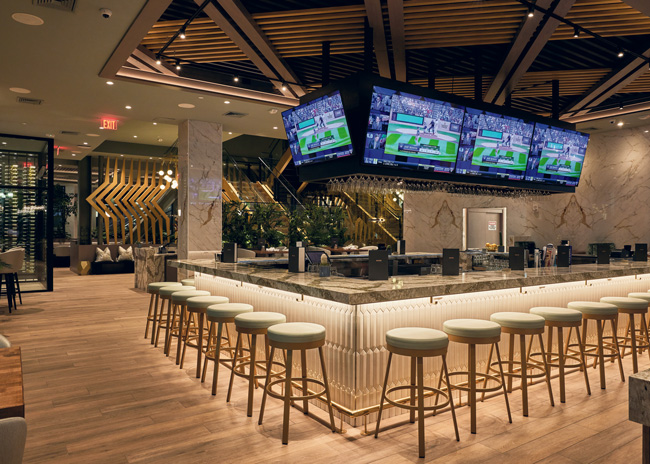 Images courtesy of Moxies
Images courtesy of Moxies
According to Halpert, Moxies’ move into the United States is just part of its natural growth. With 50 restaurants in Canada, the chain isn’t completely saturated there, but opportunities aren’t as plentiful as they once were. The United States, however, has more markets with the population density, disposable income and other demographics that light up Moxies’ spreadsheets.
These same spreadsheets tell Moxies not to focus on specific geographies. Instead, the chain targets prime real estate in prime markets. One example is Boston’s high-end Seaport District, home to multiple four- and five-star hotels — and the newest Moxies in the U.S. Another example is Chicago’s upscale Gold Coast neighborhood, which will house a future Moxies. The company is also expanding into top real estate markets in high-end suburbs, like Southlake, Texas, where the median household income checks in at more than $250,000, per U.S. Census Bureau data. In fact, the chain is already on Southlake’s Main Street in the Town Square.
And that’s just for starters. “We are looking at prime markets as kind of the front door into the United States,” Halpert says. “Once we have planted our flag, we will look into secondary and tertiary markets — markets where there might be an opportunity for one or two Moxies.”
Moxies is so committed to this real estate strategy that it serves as the leaseholder on all its restaurants, even franchised locations. In those cases, the franchisee is the subtenant.
This arrangement has several benefits, Halpert says. Moxies’ corporate entity is more attractive to landlords than a single-unit franchisee, making it more likely to win prime locations. In addition, the setup makes it easier for the chain to step in should the franchisee run into trouble. In very rare cases, he notes, the company will actually change the concept to another Northland brand if Moxies does not thrive in a particular location.
 Booths at Moxies are upholstered in suede. The chain uses plants to help break up spaces and divide areas.
Booths at Moxies are upholstered in suede. The chain uses plants to help break up spaces and divide areas.
Sparing No Expense
This prime real estate in prime markets naturally gets a prime design, with no penny spared, says Halpert. “We have found that when we spend the money on these beautiful locations, the returns come at probably a higher level than some of our competitors who might not spend as much launching their locations,” he says. Much of the expense is on finishes like the solid granite bar top, hardwood floors and booths upholstered in suede.
Future Moxies will differ somewhat in appearance from existing locations. The chain formed a partnership with international studio DesignAgency to create future Moxies restaurants in the United States. Going forward, Halpert says, new stores will be brighter than before, with more windows to let in natural light. The company will also upgrade its art package and introduce more sustainable design elements.
One key element of sustainability will be the use of more plants, Halpert says. For instance, they may serve as barriers between booths, creating intimate spaces without the use of a manufactured divider.
Restaurants will also differ based on their home market, with elements that celebrate that neighborhood or city and a design that caters to the target customer base. “Chicago would be a really good example,” says Halpert. “We are right in the heart of an area that is very corporately driven, so we’re going to have private dining rooms and more larger tables versus smaller tables. We’re really going to try to suit our design to that guest that we feel will be a primary diner for us.”
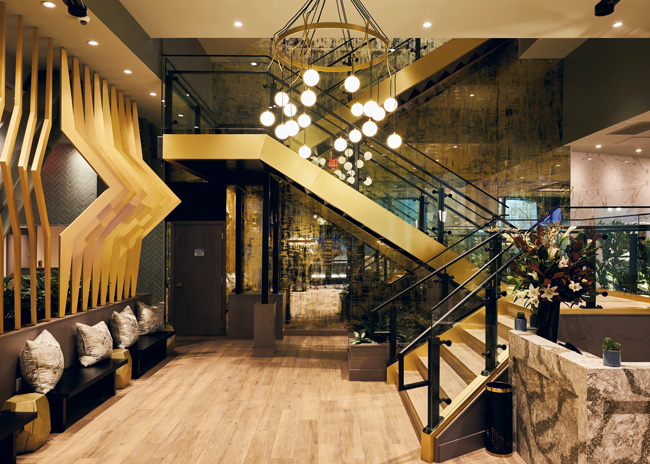
Some features will be standard across all Moxies, both old and new, including a large living wall and a wine display behind glass walls. The latter, notes Halpert, is both attractive and practical. “It’s useful both from a storage perspective and from an ambience perspective,” he says. “You obviously need somewhere to store great bottles of wine. Why not store them on display and let guests see what they are about to drink?”
Moxies restaurants also feature two distinct areas: the dining room, for more intimate occasions like date night or a business dinner, and the bar/lounge, offering a more casual setting. The bar is a bit louder and darker than the dining room. The island bar, which is either rectangular or horseshoe shaped, serves as the centerpiece of this space. The bar layout encourages connections among the bartenders, guests sitting at the bar and guests at high-top bar tables, says Halpert.
Moxies also offers a late-night menu, which the chain considers a key differentiator in competitive markets, Halpert says.
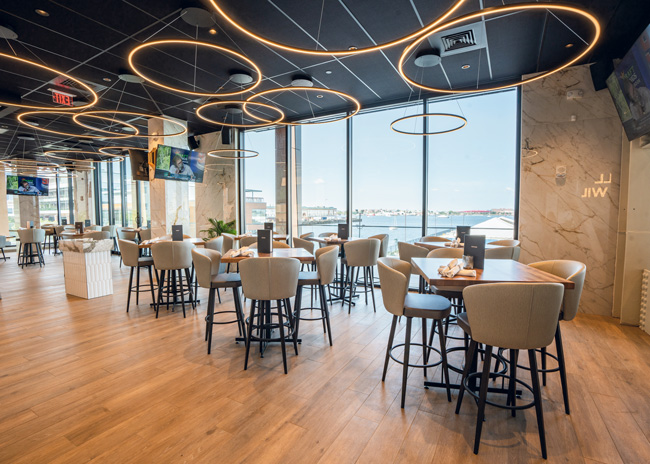 The Boston Moxies is located in the city’s seaport area. The restaurant’s design takes advantage of the view.
The Boston Moxies is located in the city’s seaport area. The restaurant’s design takes advantage of the view.
A Stacked Kitchen
The menu at Moxies, whether late-night, lunch, dinner or weekend brunch, reflects the chain’s “premium casual” branding.
Take the U.S.’s newest Moxies, located in Boston. Appetizers range from about $15 for pot stickers and, in a nod to the chain’s Canadian roots, poutine, to nearly $30 for crabcakes and crab dip. There are also burgers (around $20) and steaks (up to $67), as well as entrees like blackened mahi mahi ($33), a full rack of baby back ribs ($39) and pork belly ramen ($28).
Accompanying these offerings is an extensive wine list and a drink menu that includes sangrias and spritzes, agave-based cocktails, martini-inspired drinks and zero-proof offerings.
While the bar handles the drinks, the food is prepared in a kitchen that’s built out for a high-volume, high-quality operation like Moxies. The production area’s hot line starts with a 6-foot flattop grill, where cooks create dishes like seared salmon and seared pot stickers. Prior to cooking, items destined for the flattop are held in refrigerated drawers below the unit.
Next to the flattop sits a small refrigerated table with wells, where sauces, butters and other accoutrements are held. This piece is used by the flattop station as well as the next piece of cooking equipment, a chargrill, which typically measures 4 to 6 feet and is used to cook ribs, chicken and hamburgers.
“We do our burgers on a chargrill because we cook them to guests’ specifications,” says Brandon Thordarson, who has served as executive chef and culinary director at Moxies for the past 13 years. “We find it’s a lot easier to control the temperature of the meat on an open flame than it is on a flattop, where it goes from 100 degrees F to 150 degrees F really quickly. On a broiler, you can maintain and manage a little better.”
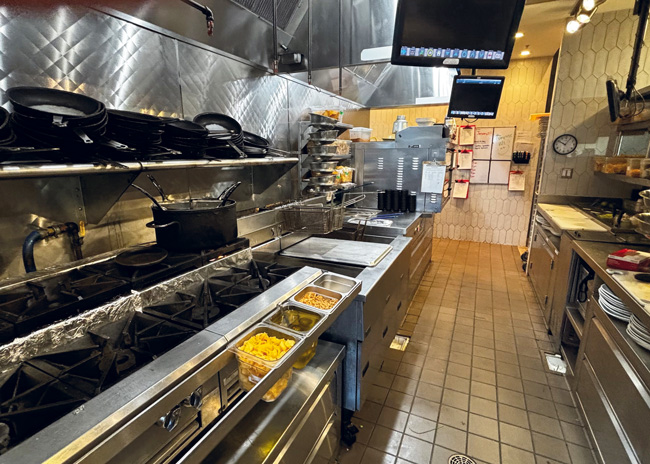 The two-level range on the hot line is used for pasta dishes and for eggs at weekend brunch.
The two-level range on the hot line is used for pasta dishes and for eggs at weekend brunch.
Next to the chargrill is another small refrigerated table and an overfired broiler for steaks. The broiler, says Thordarson, seals in juices while providing an outstanding sear and crust on the prime cuts of meat Moxies uses.
Culinary staff cook pasta dishes, as well as egg dishes ordered during brunch service, at a tiered saute station with 10 burners. The station is next to a bank of four fryers and an upright refrigeration unit that holds items bound for the fryers.
The last piece on the hotline is an oven. Moxies has recently swapped out a standard convection unit for a high-end, programmable combi oven, both here on the line and in the prep area. “Those are great because you make fewer mistakes,” says Thordarson. “The food cooks more consistently; there’s less waste.”
Accompanying the hot equipment is an assembly line just a 180 degree turn away. This space has hot wells for hot sides, along with cold wells for salads and sandwich toppings. It’s also home to a tortilla chip warmer, a toaster and a microwave. Once dishes are assembled in this area, they’re placed on a pass-through window, where expediters apply the finishing touches before sending them to guests.
Moxies also has an extensive food prep area. This space contains the previously mentioned combi oven, a large floor mixer for desserts and other items, and two kettles used to make sauces, stocks and pastas.
With a prep list of around 160 items, this area is busy throughout most of the day, says Thordarson. The prep team of four to five people usually arrives between 6 a.m. and 7 a.m., and prep ends around 7 p.m.
Including 2 on expo, a dishwasher and 12-15 staff on the line during peak hours, there can be a team of 20-25 working in Moxies’ back of house.
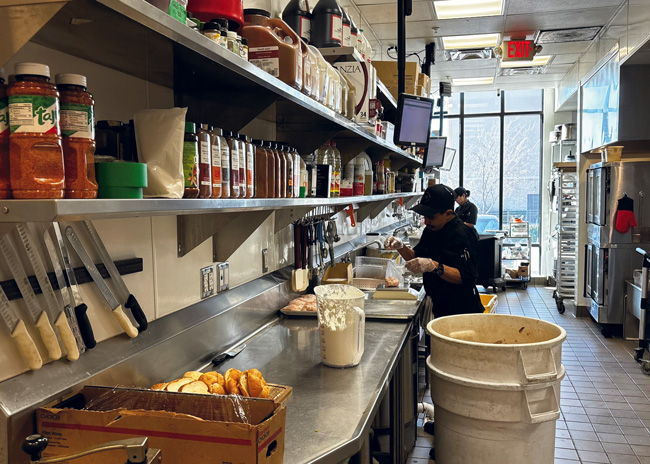 Moxies has a prep list of around 160 items. Its prep area, shown here, is used throughout the day.
Moxies has a prep list of around 160 items. Its prep area, shown here, is used throughout the day.
Optimal Franchisees
Given that it’s such a large and complex operation, it’s no surprise that Moxies seeks franchisees with hospitality industry experience, ideally with multiunit concepts.
That’s far from the only requirement, though. The large kitchen and high-end dining room make Moxies a considerable investment. According to Halpert, building a new location in an empty shell costs between $7 million and $10 million. That price may be less when moving into a second-generation restaurant space and using existing infrastructure, he notes. The price point can make finding franchisees difficult. “That takes a special type of person,” he says. “Not everybody has the ability to inject $10 million into a new opportunity, especially one that is still fresh in the United States.”
Adding to this challenge is Moxies’ relatively low profile in the U.S. So far, most Moxies franchisees in the States have a connection to the brand in Canada. Building new partnerships for U.S. locations is an area of focus, Halpert says.
As Halpert pursues such partnerships, he’s also targeting specific markets. Key areas include Atlanta, the Carolinas (especially North Carolina), Denver and New York City.
While there are a limited number of franchisees who check every box for Moxies, those who do can thrive, the company believes. The chain offers an experience between casual and fine dining that many guests are looking for, says Halpert. “Casual restaurants like Applebee’s and Chili’s might have a lower-priced menu or less of a design element,” he explains. “Some of the higher-end restaurants, the high-end steakhouses, [are places] where you are spending $100 a person and might only visit once or twice a year. Moxies is there for every person to enjoy whenever they choose to enjoy it.”



